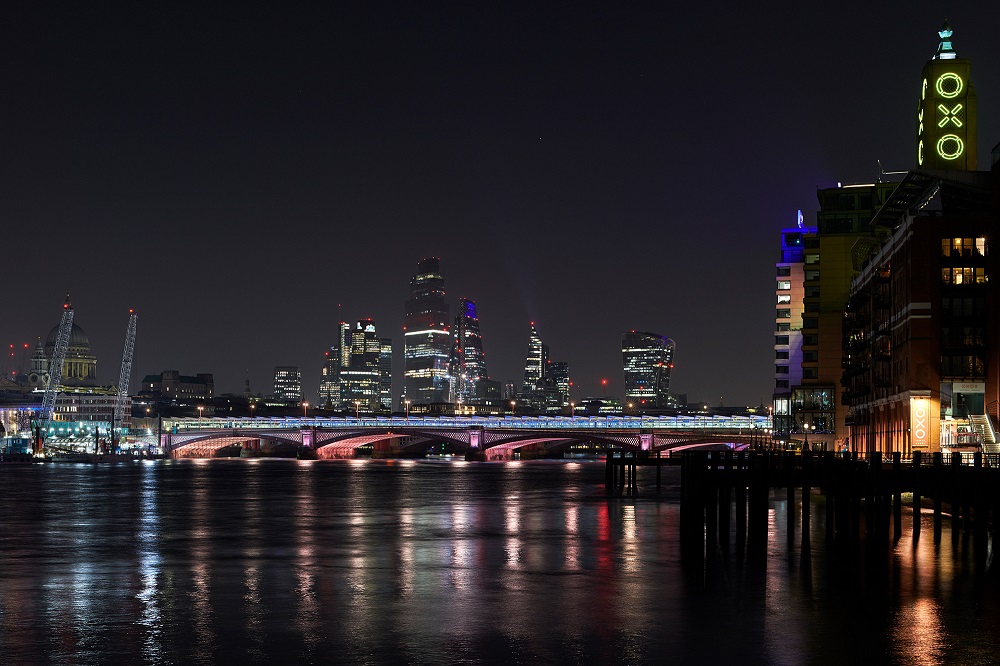Five more bridges in central London have been lit up as part of a major art project to brighten up the Thames.
They are some of the most iconic sites in the capital and have been commemorated in literature and art for centuries – from poet Wordsworth’s ‘On Westminster Bridge’ to legendary painter Claude Monet’s impressionistic views.
The latest bridges to be lit up are Blackfriars, Waterloo, Golden Jubilee, Westminster and Lambeth.
So when the light dims people can enjoy a Waterloo Sunset in style.
They join the first four bridges to be lit up – London Bridge, Cannon Street, Southwark and the Millennium Bridge, which were illuminated in 2019 to start off the ten-year project.
The project by US artist Leo Villareal has been years in the planning. At 3.2 miles it is the longest public art commission in the world.
The launch marks the end of one of the largest and most detailed planning processes London has ever seen, with 30 planning permissions and 18 listed building consents granted.
It has seen the Illuminated River Foundation together with Mr Villareal and British architects, Lifschutz Davidson Sandilands work more than 50 stakeholders and project partners includes seven London boroughs, five bridge owners, Transport for London, Network Rail.
They also worked with Historic England, the London Wildlife Trust and the Royal National Lifeboat Institution to get the project off the ground.
NOW READ: Euro 2020 fan park could be coming to central London
Each bridge has a different lighting design to reflect its history – with Westminster Bridge illuminated with a green light to match the benches of the debating chamber of the House of Commons.
Meanwhile, the red glow adorning Lambeth Bridge is a nod to the benches of the House of Lords and mirrors the red accents of the bridge’s railings and arches.
They are lit up at dusk every night until 2am and the project runs until 2029, which means visitors have plenty of time to see for themselves.
Pre-pandemic London welcomed 21 million tourists in 2019, according to Visit Britain
They can also enjoy watching from home or download audio guides if coronavirus means they are not venturing into London just yet.
Because of the pandemic, Mr Villareal was unable to travel to the UK to programme the artwork in person. Instead, he used streaming technology to view and adjust the light sequences in real time from his New York studio. It transmitted footage with less than a second in time delay and allowed him to fine-tune the artwork.
And people can enjoy a series of events online including downloading compositions from students at Guildhall School of Music and Drama, in the heart of the City of London. Blind and partially-sighted people can learn more about the bridges from audio guides created with the charity VocalEyes.
Hannah Rothschild, who came up with the idea to light up the bridges, said: “The Thames is our liquid history, spanning London’s two millennia. Its bridges, each unique and essential, are the arteries connecting north, south, east and west; carrying many millions of people and goods from one shore to another, day after day…
“For too long, the Thames and its bridges have been under appreciated. Now Leo Villareal’s brilliant and imaginative design, the world’s longest public artwork, has transformed a snake of darkness into a vibrant and beautiful ribbon of light running through our midst, which will transform the bridges, boost the local night-time economy and foster a sense of wonder in these idiosyncratic and vital structures.”
Lead image by James Newton.
For the latest headlines from the City of London and beyond, follow City Matters on Twitter, Instagram and LinkedIn.







